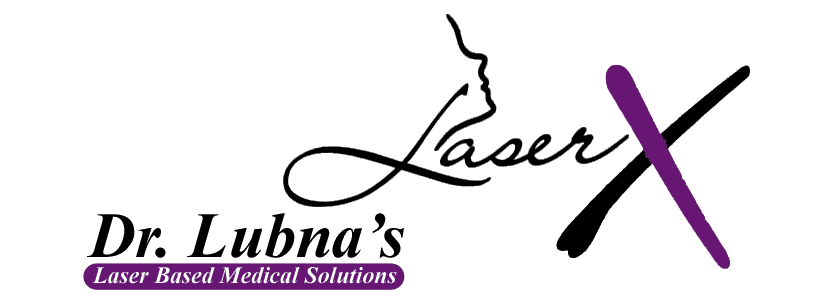- What is a chemical peel?

Dr. Lubna Says ” A chemical peel is a technique used to improve the appearance of the skin on the face, neck or hands. A chemical solution is applied to the skin that causes it to exfoliate and eventually peel off. The new, regenerated skin is usually smoother and less wrinkled than the old skin. The new skin is also temporarily more sensitive to the sun.”
- What should first be done before considering a chemical peel?
A thorough evaluation by a dermatologic surgeon is imperative before embarking upon a chemical peel.
Chemical PeelsWhen is a chemical peel appropriate?
Chemical peels are used to treat a number of conditions including:
- Acne scars
Aging skin
Crow’s feet
Scars
Sun damaged skin
Sagging skin
Wrinkles - Who is not a candidate for a chemical peel?
Generally light-haired and fair skinned people are the best candidates for chemical peel. The procedure does not work as well on dark-skinned patients. The procedure is not recommended for individuals with infections, active skin disease, cut or broken skin, sunburns or active Herpes simplex 1 sores. Other counter-indications include patients who are:
- Nursing or pregnant.
Have taken Accutane in last six months.
Have psoriasis, eczema, dermatitis or rosacea.
Have used Retin-A, Renova, prescription skin care products, products that contain ascorbic acid, bleaching or skin-lightening agents or other acid-based products in the last 48 hours.
Are chemical peels painful?
Chemicals peels sting but do not cause a great deal of pain. The gentlest peels use alpha-hydroxy, glycolic, lactic or fruit acids are also gentle. They may cause stinging, redness, irritation and crusting but as the skin begins to adjust all these problems will lessen.
Trichloroacetic acids are used for stronger peelings. They remove wrinkles, superficial blemishes and pigment problems. Phenol is the strongest of all treatments and removes deep lines and wrinkles on the face. These type of treatments sting more than those with the gentler acids. After the treatment there may be redness, swelling and irritation but the use of creams and gels will reduce these effects. Also the doctor may prescribe medicines that will help relieve the problems after the peel.
- What are the complications or potential side effects of a chemical peel?
Temporary or permanent change in skin color, particularly for women on birth control pills, who subsequently become pregnant or have a history of brownish facial discoloration.
Scarring
Reactivation of cold sores - What can I expect after having a chemical peel?
All peels require some follow-up care:
Superficial peels require one to seven days to heal. Treated skin will initially be red and may scale. Lotion or cream should be applied until the skin heals, followed by daily use of sunscreen. Makeup can usually be worn the next day.
Medium peels require seven to 14 days to heal. Treated skin will initially be red and swollen. Swelling worsens for the first 48 hours. Eyelids may swell shut. Blisters may form and break. Skin crusts and peels off in seven to 14 days. Skin must be soaked daily for a specified period, followed by ointment application. Antiviral medication is taken for 10 to 14 days. Mild lotion or cream may be applied. Avoid all sun exposure until healing is complete. Camouflage makeup may be worn after five to seven days. A follow-up appointment will be necessary to monitor progress.
Deep peels require 14 to 21 days to heal. The treated area will be bandaged. Skin must be soaked four to six times daily, followed by ointment application for the first 14 days. Afterwards a thick moisturizer is applied for the next 14 days. Antiviral medication is taken for 10 to 14 days. Mild lotion or cream may be applied. Avoid all sun exposure for three to six months. Camouflage makeup may be worn after 14 days. Several follow-up appointments will be necessary to monitor progress.
Sun exposure and smoking after a chemical peel must be avoided because they can cause unwanted side effects, including infection and scarring.
